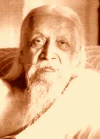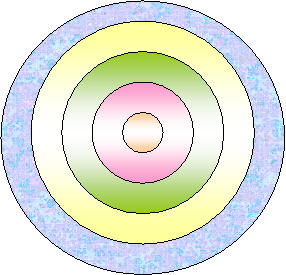| |
| |
|
|
 |What
is Taittariya Upanishad?|The
Meaning of the word "Taittariya"|Important
Considerations|Theory of Five Sheaths|Different
Functions of the Panchakosha : Physiological Aspects|The
aim of Yoga Therapy|Kosha,
Disorders related with, and suggested effective Yoga Practices|References|
|What
is Taittariya Upanishad?|The
Meaning of the word "Taittariya"|Important
Considerations|Theory of Five Sheaths|Different
Functions of the Panchakosha : Physiological Aspects|The
aim of Yoga Therapy|Kosha,
Disorders related with, and suggested effective Yoga Practices|References|
|
|
 |
Traditional texts of Yoga - 2
Therapeutics aspects discussed there in
Taittariya
Upanishad
See
other also
|Bhagavadgita|
Tattariya Upanishad|Yogopanishads|Yogavashaistha| |
 |
|
What is Taittariya Upanishad? |
|
Taittariya Upanishad belongs to the Yajurveda,
it is one of the Olderst Upansishads. It is in fact the part of the Taiitiriya
Aranyaka whose chapters 7,8,9 constitute the whole subject material of the
Taittariya Upansihad. What is remarkable about the Taittariya Upanishad that it
is one of the widely practiced and still living traditions of Indian Spiritual
heritage.
The Taittariya Upanishad is composed of three
broad chapters namely :
-
I Chapter -
शिक्षावल्ली,
-
II chapter -
ब्रह्मानन्दवल्ली
-
III chapter -
भृगुवल्ली

|
|
The Meaning of the word "Taittariya" |
|
In the fifth Mandala of the Rigveda the
indication about the meaning of the term “Tittari” is occurs, where Vedic God
Indra refers the word for the group of people who subsist on the grain
materials. Therefore, the denotative meaning of the term may be interpreted as
the “those who eats/subsists on grain articles”. Although, Taittariya Upanishads
mentions and emphasizes on the Ahara and its relation to supreme reality.
बहु
अन्नं
कुर्वीत।
..... अन्न
न
निद्यात्।
अन्नं
ब्रह्म
विजानीयात्।
 |
|
Important Considerations |
|
 Five Sheaths and their
subsequent realization leads to Brahman
Five Sheaths and their
subsequent realization leads to Brahman
 Grades of the Bliss
Grades of the Bliss
 Convocation ceremonial
Address
Convocation ceremonial
Address
 Yogic Practice
indicated : Tattariya Upanishad indicates about the “Khehari Practice”
considered as one of the profound, difficult and esoteric practice of the
HathYoga. However the word “विचिकित्सा”
occurs in Upanishad but in the sense as to indecisiveness about the right
selection.
Yogic Practice
indicated : Tattariya Upanishad indicates about the “Khehari Practice”
considered as one of the profound, difficult and esoteric practice of the
HathYoga. However the word “विचिकित्सा”
occurs in Upanishad but in the sense as to indecisiveness about the right
selection.
 |
|
Theory of Five
Sheaths |
|
Tattiriya Upanishads theory of five sheaths is
basically the interpretation of the existence in the five essential sheaths of
Kosha. These sheath are :
|
Annamaya Kosha |
|
Phsical Sheath |
|
Pranamaya Kosha |
|
Pranic or Vital Sheath |
|
Manomaya Kosha |
|
Mental Sheath |
|
Vijnanamaya Kosha |
|
Sheath of Knowledge |
|
Anandamaya Kosha |
|
Sheath of Bliss |
 |
|
The Graphical Representation
of the Kosha |
|

Fig
:
depicting
the pancha Kosha where Kosha are not separated but intermingled as the
overlapping layer like the layer of the Onion.
 |
|
Different Functions of the Panchakosha :
Physiological Aspects |
|
I.
Annamaya Kosha
is related with physical existence and this becomes possible through the
sustenance on the food. Therefore, the basic layer of the existence bilt on the
basis of Ahara. Physiologically, Annamaya kosha is related with the digestive
system of the body. The proper functioning of the digestive system is the basis
of not only the good health but longevity also. According to Gita also food
taken affects the body differently as per the quality, quantity and state of the
mind at the time of intake. Here we may sum up that the Annamaya kosha is the
important and necessary layer of existence.
II.
Pranamaya Kosha
is related with Prana which is the vital force of the body or existence. Prana
as the sole motivating force has been profusely discussed not only in the
Taittariya Upanishad but in entire Upanishadic literature. Prana, in terms of
the air inhaled signify the functioning of the lungs but also palpitation of the
Heart and blood circulation. What is significant in term of the Tattariya
Upanishad is that is describe the Prana as Vital
force----------------------------. Physiologically Pranamaya Kosha is related
directly with the Respiratory System but also Endocrine System of the body.
Upanishad in not much revealed terminology describes the methodology of the
Prana Sadhana.
III.
Manomaya Kosha
is the psychical existence; mind and functioning of the mind and their role in
life are considered. Due to improper functioning and or misbalance of the
annamaya kosha leads to psychological disorders and diseases of the nervous
system.

IV.
Vijnanamaya Kosha
is related with the consciousness. Awareness, alertness, activity and proper
growth and integrated development are all the proper and nourishing aspects of
the manifestation of the human consciousness. This human consciousness is here
referred in terms of the Vijnanamaya Kosha. Vijnana is also related with the
knowledge or more accurately knowledge of the Reality. As much as one remains to
be perfected into the realm of Vijnamaya Kosha one enjoys nearness to the
Reality. Physiologically, consciousness is the function of the brain. Although
its musterious full functioning and all aspects still lying unexplored in the
realm of Medical Science.
V.
Ananadamaya Kosha
is the Kosha/sheath related with the bliss or blissful existence. According to
Upanishad all the activities and business finally resolved or culminates in
Ananada. Anaanda is also equated with the Brahama or Supreme reality.
Physiologically, the balanced, contented and unhindered life force and life
energy generates happiness which is the basis for bliss existence.
Here with reference to above description this
is obvious that Upanishad remarkably define human existence in terms of five
sheath or Panch Kosha. Here subject matter dealt in expository language but what
are the Hathayogaic Practices i.e. Asana, Pranayama etc. not seem to be
discussed at large because of two reasons that HathaYogic development is later
development, and second that whaterver Pancha Kosha theory occuer in Upanishads
only ir refernce ot the queries of Bhrigu and his father Guru Rishi Varuna.
 |
| |
The aim of Yoga Therapy |
|
| |
The aim of Yoga therapy is to operate these
Koshas in a coordinated manner. The different techniques of Yoga will make these
Koshas to function at its optimum level. According to Yoga, the disturbance
starts at Annamaya Kosha or Manomaya kosha in the form of strong likes or
dislikes. These disturbed mental activities, when becomes uncontrolled
percolated to Pranamaya Kosha, In Pranamaya Kosha this results in Haphazard flow
of Prana and Nadis, this further acts on the annamaya kosha resulting in
Ajeernatvam (faulty digestion) and atijeertvam (over digestion). This ultimately
results in some form of disease symptoms.
When we consider the effect of disturbances on
the subtle sheaths, the following chain of reaction can be seen :
|
Disturbance in Manomaya
Kosha |
|
|
|
Distrubance in Intellect
and Knowleged and Intellect |
|
|
|
Failure to take right
decision at right time |
|
|
|
End up with Problem |
|

|
|
Loss of Ananada (Bliss) |
The techniques of Yoga can very well play in
controlling the mental disturbace. As mentioned above, the very definition of
Yoga given by Patañjali itself states that Yogaschittavritti nirodhah and
Yogavashishatha the as Manaprashamanopaya yogah (Yoga is a tool to
calm down the mental modifications)
 |
|
| |
Kosha, Disorders related with, and suggested effective Yoga Practices |
|
| |
|
S.No. |
Kosha regarding |
Related Disorder |
Efficacious Yoga
Practices |
|
1 |
Annamaya Kosha
|
Digestive, Disorder |
Padmasana, Bhujangasana, Vajrasana and its
modifications based on the practice
Nadishodhana, Anulaoma and Viloma
Om chanting |
|
2. |
Pranamaya Kosha |
Respiratory, Cardiac Disorder,
|
Simhasana, Vajrasana, Paschimottanasana,
Nadishodhana, Ujjayi, Surya Namaskar, Meditation. |
|
3. |
Manomaya Kosha |
Psychological or Mental Disorder,
Endocrinal, Disorder |
Relaxative and cultural Asanas
Nadishodhana Pranayama
Meditation |
|
4. |
Vijnanamaya Kosha |
----- do ----- |
Dharana and Pratyahara Yogic Practices,
Deep breathing and Retention (Kumbhaka) and Meditation |
|
5. |
Ananadamaya Kosha |
Various Disorders
Which hinders overall expansion expansion
of life energy, happiness and realization of blissful existence. |
The rectification of the disorders related
with Annamaya, Pranamaya and Manomaya leads to Proper channelizing of
blissful existence
Above and group of multiple Pactices as
per the identification of the case. |
Table
:
depicting Disorders regarding the Kosha and effective yoga practices.
 |
|
| |
References
-
Tattariya Upanishad,
MLBD, New Delhi
-
Tattariya Upanishad and
Commentary of Adishankaracharya,
Gita Press Gorakhapur, U.P.
-
Upanishatsamgraha,
MLBD, New Delhi
-
Constructive Survey of
Upanishadic Philosophy, R.D.
Ranadey, MLBD, New Delhi
-
Yoga Traditions
Further discussion and consideration
-
Role and realization of
Pancha Kosha - Methods and
Identification.
-
Identifying the diseases relating with the
disorders and concerning Kosha.
 |
|
| |
|
|
|